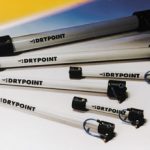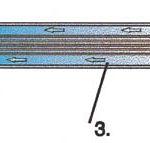Moist compressed air is a source of trouble in nearly all compressed air applications. Drying compressed air using membrane dryers has established itself as a third option alongside the traditional methods of refrigeration drying or adsorption drying.
Jörg Rambow, Gernot Huckele, Rainer Stützel
Moisture and corrosion in the compressed-air supply system lead to faults in control devices and systems and can interfere considerably with the production schedule. Any metal parts that are constantly, or from time to time, in contact with moist compressed air or condensate will certainly corrode. A relative humidity value for the compressed air of more than 40 % is the critical limit here (Fig. 1).
Traditional drying methods
In most cases the compressed air is dried, normally using a refrigeration dryer, with the aim of avoiding the above problems. The maximum pressure dew point that can be achieved with compressed-air refrigeration dryers is between 3 °C and 5 °C, so that the compressed air has a water-vapour content of about 6 g/m³ to 7 g/m³. This means that there is still quite a potential for corrosion, even at room temperature and despite compressed-air drying. At room temperatures between 18 °C and 21 °C, compressed air with this amount of water vapour is close to the 40% mark. Yet what happens when the room temperature drops at night or during the cold season? Simple enough: the relative humidity of the compressed air increases and so does the likelihood of corrosion.
Operators have so far been faced with the following choice: they could either try to live with the problem and, as a precaution, regularly replace any parts in danger of corrosion, or they could employ additional air-drying systems, usually cold-regenerated or one-way adsorption dryers.
In practice, both systems have significant disadvantages. One-way cartridges cannot be regenerated after being loaded with moisture. In the case of high moisture contents, one has to ask the question whether it would not be cheaper after all to replace the valves and cylinders instead of always buying new cartridges.
There are similar problems with cold-re-generated adsorption dryers. The service life of the adsorbers is limited, and one also needs to take the costs of prefiltration and afterfiltration into account. The cyclic replacement of the adsorbers causes considerable noise, while a fairly large amount of compressed air has to be used for regeneration.
Membrane dryers
Drypoint membrane dryers are a good solution for the above applications involving partial-flow or end-point drying. In addition to the membrane module, the membrane dryer includes a prefilter with condensate drain for removing any liquid condensate, and in some cases also a microfilter with a condensate drain for retaining oil vapour.
In contrast to the familiar methods of compressed-air drying, the Drypoint membrane dryer functions on the basis of diffusion equilibration. Filtered, compressed air that is still moist enters the module and flows through a bundle of highly selective hollow-fibre membranes (1). At the outlet of the module, a small part of the compressed air is diverted and expanded (2). This partial flow, referred to as purge air, then moves along the outside of the membranes. Due to the expansion to atmospheric pressure, the purge air is considerably drier than the compressed air passing through the hollow fibres. Since the membrane is permeable to water vapour, this results in a permanent equilibration of the water vapour concentration: water vapour from the moist compressed air diffuses into the drier purge air (3). The purge air that has absorbed the moisture is discharged into the environment, without producing condensate.
The entire process is continuous. Compressed air is constantly being supplied and purge air generated, while equilibration of the water vapour through the membrane takes place at the same time. In this manner, the compressed air is dried continuously. The system allows the pressure dew point to be lowered freely, i.e. the water vapour content between the inlet and outlet sides of the module can be reduced.
Membrane drying as a new approach for lowering the pressure dew point
Membrane dryers used to be associated with a high energy demand due to their consumption of purge air. This was certainly true some years ago during the initial phase, when only low-selectivity membranes were available. With this type of dryer, the purge air is diffused through the membrane. The quantity of purge air is therefore a pressure-dependent material constant. It is not possible to influence the purge-air flow by technical means, so that plant components, for example, cannot be used to control it.
With highly selective membranes, on the other hand, the purge-air nozzle at the mod-ule outlet permits optimum adjustment of the purge-air amount – and thus of the required pressure dew point – for the particular application. High-selectivity Drypoint membranes can only be penetrated by water vapour, so that the composition of the air remains unchanged. Consequently, these membranes are also suitable for respiratory air applications.
The operator is therefore presented with a new concept for determining the dew point. While the dew points of refrigeration dryers and adsorption dryers are fixed according to the drying agent, the Drypoint membrane dryer automatically adapts to the actual environmental conditions of the application. This is not a functional principle that applies only for a limited time, but a system that will continue to operate reliably for many years to come. In addition to this aspect, Drypoint membrane dryers offer numerous other advantages:
• wear- and maintenance-free dryer modules, ensuring dry compressed air over a period of many years,
• compact, space-saving design, permitting simple installation irrespective of the posi-tion,
• full environmental compatibility without the use of drying agents, CFCs or FCs that require disposal,
• immediate availability of dried compressed air, even with intermittent operation.
Conclusion
Compressed-air drying using membranes opens up potentially interesting applications and supplements the traditional drying methods. The technical advantages of the membrane dryer, its efficiency and its low operating costs make it a viable alternative compared with other devices. In terms of cost, membrane dryers are able to undercut adsorption dryers quite considerably. The basic condition is that the purge-air flow must be controllable, in other words it is essential to use only highly selective membranes.
Further information cpp-247
Unsere Webinar-Empfehlung
Die Websession „Wasserstoff in der Chemie – Anlagen, Komponenten, Dienstleistungen“ (hier als Webcast abrufbar) zeigt technische Lösungen auf, die die Herstellung und Handhabung von Wasserstoff in der chemischen Industrie sicher machen und wirtschaftlich gestalten.
Ob effizienter…
Teilen:













